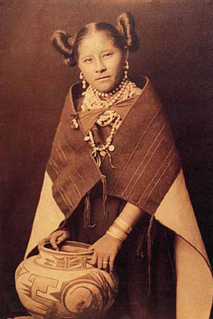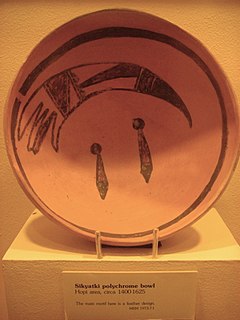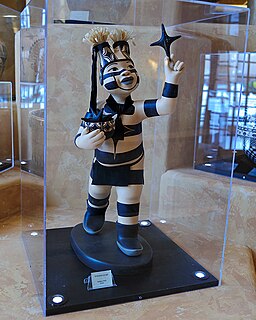Related Research Articles

The Hopi are a Native American tribe who primarily live on the Hopi Reservation in northeastern Arizona. As of the 2010 census, there are 19,338 Hopi in the United States. The Hopi Tribe is a sovereign nation within the United States and has government-to-government relations with the United States federal government. Particular villages retain autonomy under the Hopi Constitution and Bylaws. The Hopi language is one of 30 in the Uto-Aztecan language family. The majority of Hopi people are enrolled in the Hopi Tribe of Arizona but some are enrolled in the Colorado River Indian Tribes. The Hopi Reservation covers a land area of 2,531.773 sq mi (6,557.26 km2).

The Hopi maintain a complex religious and mythological tradition stretching back over centuries. However, it is difficult to definitively state what all Hopis as a group believe. Like the oral traditions of many other societies, Hopi mythology is not always told consistently and each Hopi mesa, or even each village, may have its own version of a particular story. But, "in essence the variants of the Hopi myth bear marked similarity to one another." It is also not clear that the stories told to non-Hopis, such as anthropologists and ethnographers, represent genuine Hopi beliefs or are merely stories told to the curious while keeping safe the more sacred Hopi teachings. As folklorist Harold Courlander states, "there is a Hopi reticence about discussing matters that could be considered ritual secrets or religion-oriented traditions."

A kachina is a spirit being in the religious beliefs of the Pueblo peoples, Native American cultures located in the south-western part of the United States. In the Pueblo cultures, kachina rites are practiced by the Hopi, Zuni, Hopi-Tewa, and certain Keresan tribes, as well as in most Pueblo tribes in New Mexico.

The San Francisco Peaks are a volcanic mountain range in San Francisco volcanic field in north central Arizona, just north of Flagstaff and a remnant of the former San Francisco Mountain. The highest summit in the range, Humphreys Peak, is the highest point in the state of Arizona at 12,633 feet (3,851 m) in elevation. The San Francisco Peaks are the remains of an eroded stratovolcano. An aquifer within the caldera supplies much of Flagstaff's water while the mountain itself is in the Coconino National Forest, a popular recreation site. The Arizona Snowbowl ski area is on the western slopes of Humphreys Peak, and has been the subject of major controversy involving several tribes and environmental groups.
The Hopi-Tewa are a Tewa Pueblo group that resides on the eastern part of the Hopi Reservation on or near First Mesa in northeastern Arizona.

Walpi,, is a Hopi village established around 900 AD. It is located above Arizona State Route 264, east of the Grand Canyon in Navajo County, northern Arizona. Walpi is the Hopi term for "place of the notch." Historically, the village has also been known as Ash Hill Terrace, Gaspe, Gualpi, Hualpi, Kuchapturela, Valpee, and Wolpi. Walpi became the official name as a result of a decision of the Board on Geographic Names in 1915.

The Dark Wind is the fifth crime fiction novel in the Joe Leaphorn / Jim Chee Navajo Tribal Police series by Tony Hillerman, published in 1982. It is the second of the novels to feature Officer Jim Chee.

The Pueblo clowns are jesters or tricksters in the Kachina religion. It is a generic term, as there are a number of these figures in the ritual practice of the Pueblo people. Each has a unique role; belonging to separate Kivas and each has a name that differs from one mesa or pueblo to another.

Hopi katsina figures, also known as kachina dolls, are figures carved, typically from cottonwood root, by Hopi people to instruct young girls and new brides about katsinas or katsinam, the immortal beings that bring rain, control other aspects of the natural world and society, and act as messengers between humans and the spirit world.
Ahöla, also known as Ahul, is a spirit being, a kachina, embodied by a man, in Hopi religion.
Kikmongwi are traditional village chiefs on the Hopi Reservation in Northeastern Arizona.

Fred Kabotie was a celebrated Hopi painter, silversmith, illustrator, potter, author, curator and educator. His native name in the Hopi language is Naqavoy'ma which translates to Day After Day.
In Hopi mythology Nataska is the uncle of the family of "ogre Katsinas" who guard Soyok Wuhti, and who enforce good behavior among the children. Nataska is a Mongkatsina. Wiharu is a similar or identical Katsina with a white rather than black face.
Kököle are 'spirit dolls' of the Zuni Indians.

Polacca is an unincorporated community in Navajo County, of northeastern Arizona, United States. It is Hopi-Tewa community on the Hopi Reservation.

Art of the American Southwest is the visual arts of the Southwestern United States. This region encompasses Arizona, New Mexico, and parts of California, Colorado, Nevada, Texas, and Utah. These arts include architecture, ceramics, drawing, filmmaking, painting, photography, sculpture, printmaking, and other media, ranging from the ancient past to the contemporary arts of the present day.

Neil Randall David, Sr. Is a Hopi-Tewa American Indian artist and katsina carver. He learned the basics of carving from his grandfather Victor (Kawayo) Charlie.

Tsaveyo is the Giant Ogre kachina, one of the Hopi spirit beings. There are numerous Hopi stories and legends about him. These date from the time of the Hopi migrations.

The Hopi Cultural Center is a place in the Hopi Reservation on Second Mesa, Arizona where visitors can learn about the culture, history and art of the Hopi people. It also provides lodging and a restaurant that serves Hopi cuisine. A museum is also part of the cultural center. Hopi ceremonies also take place at the center, although many of these are not open to the public.

Waldo Mootzka (1903–1940) was a Hopi watercolor artist.
References
- ↑ Journal of American Folklore. American Folklore Society. 1947. p. 32.
- ↑ Werner Müller (1989). America, the New World Or the Old?. Verlag Peter Lang. p. 125. ISBN 978-3-631-40486-7.
Source: The 17th Annual Report of the Bureau of American Ethnology, ed. J.W. Powell, 1895, page 619.